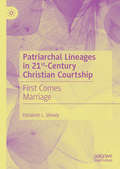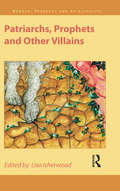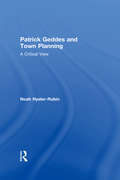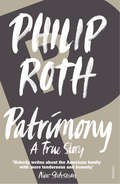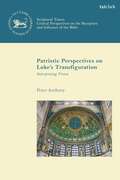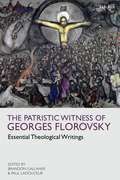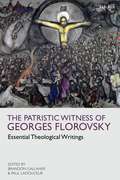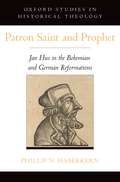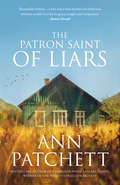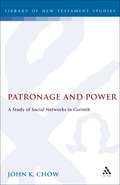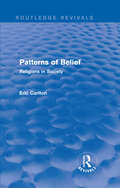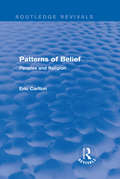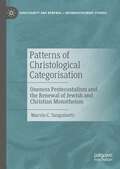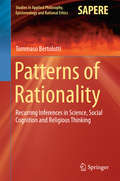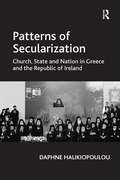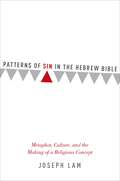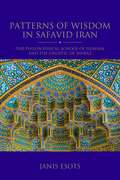- Table View
- List View
Patriarchal Lineages in 21st-Century Christian Courtship: First Comes Marriage
by Elizabeth L. ShivelyDrawing from a study of courtship media and ethnographic work at purity retreats and home-school conventions across the Midwest, this is the first inquiry into modern Christian courtship, an alternative to dating that asks young people to avoid both romance and sex until they are ready to be married. Bridging sociological and historical studies of American Christianity with youth and girlhood studies literatures, Elizabeth Shively finds that the courtship system is designed to shore up the patriarchal nuclear family structure at the center of conservative Christianity and ensure predictability in the face of emerging adulthood: single young women work to embody ideals of “luminous femininity” and model themselves after archetypes such as the “Proverbs 31 woman,” the “stay-at-home-daughter,” and the “mission-minded girl,” and courting couples strive to “guard their hearts” against premature emotional intimacy. Nonetheless, participants report that courtship, like other relationships, inevitably carries an element of risk, and it ultimately fails to offer a substantial challenge to the to the sexist realities of youth dating culture.
Patriarchs, Prophets and Other Villains (Gender, Theology and Spirituality)
by Lisa IsherwoodPatriarchs, Prophets and Other Villains takes as a starting point the hermeneutics of suspicion. The book illustrates the way in which texts and interpretations have been manipulated for the purpose of power and control. Through careful-counter readings it challenges the ways in which the female divine has been pushed back by relentless male interpretation and misrepresentation. The essays range across liberation theology and queer theory to sexual hospitality and the 'Song of Songs' as a challenge to hetero-patriarchy. The book provides an accessible resource for any student interested in the ways in which narrow readings of Scripture can become a power base for hierarchies of exclusion.
Patriarchs, Prophets and Other Villains (Gender, Theology and Spirituality)
by Lisa IsherwoodPatriarchs, Prophets and Other Villains takes as a starting point the hermeneutics of suspicion. The book illustrates the way in which texts and interpretations have been manipulated for the purpose of power and control. Through careful-counter readings it challenges the ways in which the female divine has been pushed back by relentless male interpretation and misrepresentation. The essays range across liberation theology and queer theory to sexual hospitality and the 'Song of Songs' as a challenge to hetero-patriarchy. The book provides an accessible resource for any student interested in the ways in which narrow readings of Scripture can become a power base for hierarchies of exclusion.
Patrick Geddes and Town Planning: A Critical View
by Noah Hysler-RubinPatrick Geddes is considered a forefather of the modern urban planning movement. This book studies the various, and even opposing ways, in which Geddes has been interpreted up to this day, providing a new reading of his life, writing and plans. Geddes' scrutiny is presented as a case study for Town Planning as a whole. Tying together for the first time key concepts in cultural geography and colonial urbanism, the book proposes a more vigorous historiography, exposing hidden narratives and past agendas still dominating the disciplinary discourse. Written by a cultural geographer and a town planner, this book offers a rounded, full-length analysis of Geddes' vision and its material manifestation, functioning also as a much needed critical tool to evaluate Modern Town Planning as an academic and practical discipline. The book also includes a long overdue model of his urban theory.
Patrick Geddes and Town Planning: A Critical View
by Noah Hysler-RubinPatrick Geddes is considered a forefather of the modern urban planning movement. This book studies the various, and even opposing ways, in which Geddes has been interpreted up to this day, providing a new reading of his life, writing and plans. Geddes' scrutiny is presented as a case study for Town Planning as a whole. Tying together for the first time key concepts in cultural geography and colonial urbanism, the book proposes a more vigorous historiography, exposing hidden narratives and past agendas still dominating the disciplinary discourse. Written by a cultural geographer and a town planner, this book offers a rounded, full-length analysis of Geddes' vision and its material manifestation, functioning also as a much needed critical tool to evaluate Modern Town Planning as an academic and practical discipline. The book also includes a long overdue model of his urban theory.
Patrimony: A True Story (Vintage International Series)
by Philip RothPatrimony is a true story about the relationship between a father and a son.Philip Roth watches as his eight-six-year-old father, famous for his vigour, his charm and his skill as a raconteur - lovingly called 'the Bard of Newark' - battles with the brain tumour that will kill him. The son, full of love, anxiety and dread, accompanies his father through each fearful stage of his final ordeal, and, as he does so, discloses the survivalist tenacity that has distinguished his father's long engagement with life. Written with fierce tenderness, Patrimony is a classic work of memoir by a master storyteller.
Patristic Perspectives on Luke’s Transfiguration: Interpreting Vision (The Library of New Testament Studies)
by Peter AnthonyPeter Anthony explores how visionary elements in Luke's Gospel had a particular influence on early interpretation of the Transfiguration, by examining the rich hermeneutical traditions that emerged - particularly in the Latin West - as the Transfiguration was first depicted visually in art.Anthony begins by comparing the visual and visionary culture of antiquity with that of the present, and their differing interpretations of the Transfiguration. He then examines the Transfiguration texts in the synoptic gospels and their interpretation in modern scholarship, and the reception of the Transfiguration in 2 Peter, the Apocalypse of Peter and the Acts of Peter, Tertullian and Origen. Proceeding to look at interpretations found in the Greek East and the Latin West, Anthony finally discusses the earliest visual depictions of the Transfiguration from the sixth century onward, drawn from a wealth of different art forms. Anthony concludes that early commentators' and artists' understanding of how we see and visualise, and therefore, how the Transfiguration was apprehended, is closer to that of the writers of the New Testament than many modern interpreters' is.
Patristic Perspectives on Luke’s Transfiguration: Interpreting Vision (The Library of New Testament Studies)
by Peter AnthonyPeter Anthony explores how visionary elements in Luke's Gospel had a particular influence on early interpretation of the Transfiguration, by examining the rich hermeneutical traditions that emerged - particularly in the Latin West - as the Transfiguration was first depicted visually in art.Anthony begins by comparing the visual and visionary culture of antiquity with that of the present, and their differing interpretations of the Transfiguration. He then examines the Transfiguration texts in the synoptic gospels and their interpretation in modern scholarship, and the reception of the Transfiguration in 2 Peter, the Apocalypse of Peter and the Acts of Peter, Tertullian and Origen. Proceeding to look at interpretations found in the Greek East and the Latin West, Anthony finally discusses the earliest visual depictions of the Transfiguration from the sixth century onward, drawn from a wealth of different art forms. Anthony concludes that early commentators' and artists' understanding of how we see and visualise, and therefore, how the Transfiguration was apprehended, is closer to that of the writers of the New Testament than many modern interpreters' is.
The Patristic Witness of Georges Florovsky: Essential Theological Writings
by Georges FlorovskyGeorges Florovsky (1893-1979) was one of the most prominent Orthodox theologians and ecumenists of the twentieth century. His call for a return to patristic writings as a source of modern theological reflection had a powerful impact not only on Orthodox theology in the second half of the twentieth century, but on Christian theology in general. Florovsky was also a major Orthodox voice in the ecumenical movement for four decades and he is one of the founders of the World Council of Churches.This book is a collection of major theological writings by George Florovsky. It includes representative and widely influential but now largely inaccessible texts, many newly translated for this book, divided into four thematic sections: Creation, Incarnation and Redemption, The Nature of Theology, Ecclesiology and Ecumenism, and Scripture, Worship and Eschatology.A foreword by Metropolitan Kallistos Ware presents the theological vision of Georges Florovsky and discusses the continuing relevance of his work both for Orthodox theology and for modern theology in general. The introduction by the Editors provides a theological and historical overview of Florovsky theology in teh context of his biography. The book includes explanatory notes, translation of patrisitc citations and an index.
The Patristic Witness of Georges Florovsky: Essential Theological Writings
by Georges FlorovskyGeorges Florovsky (1893-1979) was one of the most prominent Orthodox theologians and ecumenists of the twentieth century. His call for a return to patristic writings as a source of modern theological reflection had a powerful impact not only on Orthodox theology in the second half of the twentieth century, but on Christian theology in general. Florovsky was also a major Orthodox voice in the ecumenical movement for four decades and he is one of the founders of the World Council of Churches.This book is a collection of major theological writings by George Florovsky. It includes representative and widely influential but now largely inaccessible texts, many newly translated for this book, divided into four thematic sections: Creation, Incarnation and Redemption, The Nature of Theology, Ecclesiology and Ecumenism, and Scripture, Worship and Eschatology.A foreword by Metropolitan Kallistos Ware presents the theological vision of Georges Florovsky and discusses the continuing relevance of his work both for Orthodox theology and for modern theology in general. The introduction by the Editors provides a theological and historical overview of Florovsky theology in teh context of his biography. The book includes explanatory notes, translation of patrisitc citations and an index.
Patron Saint and Prophet: Jan Hus in the Bohemian and German Reformations (Oxford Studies in Historical Theology)
by Phillip N. HaberkernThe Bohemian preacher and religious reformer Jan Hus has been celebrated as a de facto saint since being burned at the stake as a heretic in 1415. Patron Saint and Prophet analyzes Hus's commemoration from the time of his death until the middle of the following century, tracing the ways in which both his supporters and his most outspoken opponents sought to determine whether he would be remembered as a heretic or saint. Phillip Haberkern examines how specific historical conflicts and exigencies affected the evolution of Hus's memory-within the militant Hussite movement that flourished until the mid-1430s, within the Czech Utraquist church that succeeded it, and among sixteenth-century Lutherans who viewed Hus as a forerunner and even prophet of their reform. Using close readings of written sources such as sermons and church histories, visual media including manuscript illuminations and monumental art, and oral forms of discourse such as vernacular songs and liturgical prayers, this book offers a fascinating account of how changes in media technology complemented the shifting theology of the cult of saints in order to shape early modern commemorative practices. By focusing on the ways in which the invocation of Hus catalyzed religious dissent within two distinct historical contexts, Haberkern compares the role of memory in late medieval Bohemia with the emergence of history as a constitutive religious discourse in the early modern German land. In this way, he also provides a detailed analysis of the ways in which Bohemian and German religious reformers justified their dissent from the Roman Church by invoking the past.
The Patron Saint of Liars
by Ann PatchettThe first novel from the bestselling author of The Dutch House, Commonwealth and Bel Canto, Winner of The Women’s Prize for Fiction and the Pen/Faulkner Award.
Patronage and Power: A Study of Social Networks in Corinth (The Library of New Testament Studies #75)
by John K. ChowFrom 1 Corinthians we know that the church at Corinth was beset by all sorts of problems. Some of these problems resulted from contacts with the pagan world - one member of the church cohabited with his stepmother, one brought a suit against another brother before the pagan magistrate, some ate idolatrous feasts at the pagan temple, and others underwent baptism for the dead. This refreshing and stimulating book seeks to understand the significance of these problems from the perspective of the social structures and conditions of this Graeco-Roman city, and places Paul's response to them in the same context.
Patterns of Belief: Religions in Society
by Eric CarltonThe principle purpose of Religious Education has traditionally been to instruct and inform, with discussion and questioning occupying a secondary position. This traditional approach gives overwhelming emphasis to the historical aspects of religion, and not only fails to put into perspective the issues raised by religion today, but also takes no account of the growing movement in schools towards learning by enquiry and questioning rather than by the accumulation of stated facts. This title, first published in 1973, explores the ways in which religion can be approached from a more sociological standpoint, and aims to encourage the reader to examine religion in a more objective manner. The wide-ranging and exploratory theme of this book makes it ideal for follow-up work and suggestions for further study are provided after each chapter. This title will be of interest to teachers and students of Religious Studies.
Patterns of Belief: Peoples and Religion
by Eric CarltonThe principle purpose of Religious Education has traditionally been to instruct and inform, with discussion and questioning occupying a secondary position. This traditional approach gives overwhelming emphasis to the historical aspects of religion, and not only fails to put into perspective the issues raised by religion today, but also takes no account of the growing movement in schools towards learning by enquiry and questioning rather than by the accumulation of stated facts. This title, first published in 1973, explores the ways in which religion can be approached from a more sociological standpoint, and aims to encourage the reader to examine religion in a more objective manner. The wide-ranging and exploratory theme of this book makes it ideal for follow-up work and suggestions for further study are provided after each chapter. This title will be of interest to teachers and students of Religious Studies.
Patterns of Belief: Peoples and Religion (Routledge Revivals Ser.)
by Eric CarltonThe principle purpose of Religious Education has traditionally been to instruct and inform, with discussion and questioning occupying a secondary position. This traditional approach gives overwhelming emphasis to the historical aspects of religion, and not only fails to put into perspective the issues raised by religion today, but also takes no account of the growing movement in schools towards learning by enquiry and questioning rather than by the accumulation of stated facts. This title, first published in 1973, explores the ways in which religion can be approached from a more sociological standpoint, and aims to encourage the reader to examine religion in a more objective manner. The wide-ranging and exploratory theme of this book makes it ideal for follow-up work and suggestions for further study are provided after each chapter. This title will be of interest to teachers and students of Religious Studies.
Patterns of Belief: Religions in Society (Routledge Revivals Ser.)
by Eric CarltonThe principle purpose of Religious Education has traditionally been to instruct and inform, with discussion and questioning occupying a secondary position. This traditional approach gives overwhelming emphasis to the historical aspects of religion, and not only fails to put into perspective the issues raised by religion today, but also takes no account of the growing movement in schools towards learning by enquiry and questioning rather than by the accumulation of stated facts. This title, first published in 1973, explores the ways in which religion can be approached from a more sociological standpoint, and aims to encourage the reader to examine religion in a more objective manner. The wide-ranging and exploratory theme of this book makes it ideal for follow-up work and suggestions for further study are provided after each chapter. This title will be of interest to teachers and students of Religious Studies.
Patterns of Christological Categorisation: Oneness Pentecostalism and the Renewal of Jewish and Christian Monotheism (Christianity and Renewal - Interdisciplinary Studies)
by Marvin C. SanguinettiThis book focuses on Christological-Monotheism, an underexplored area which combines two disciplines of theological appraisal often addressed as separate subjects. Christological-Monotheism is underexplored in the literature, and even more underexplored are interpretations of Christological-Monotheism from the perspectives of Christian voices within the “Oneness Pentecostal” faith tradition. Oneness Pentecostalism offers opposing perspectives to what is considered ‘fixed orthodoxy’ within the Christian faith traditions: i.e., its views differ on doctrines relating to the nature of God and Christ from accepted norms. This project seeks to include various Oneness Pentecostal interpretations to commonly held perspectives, and explore what such might look like when juxtapose with Christian orthodoxy. Moreover, it rereads perspectives about the relationship between God and Christ offered by both traditions in the contexts of earlier contributors to Christian history, all the way to the Second Temple Jewish periods, and includes similar patterns exposed by various groups/scholars along this trajectory.
Patterns of Rationality: Recurring Inferences in Science, Social Cognition and Religious Thinking (Studies in Applied Philosophy, Epistemology and Rational Ethics #19)
by Tommaso BertolottiThis book proposes an applied epistemological framework for investigating science, social cognition and religious thinking based on inferential patterns that recur in the different domains. It presents human rationality as a tool that allows us to make sense of our (physical or social) surroundings. It shows that the resulting cognitive activity produces a broad spectrum of outputs, such as scientific models and experimentation, gossip and social networks, but also ancient and contemporary deities. The book consists of three parts, the first of which addresses scientific modeling and experimentation, and their application to the analysis of scientific rationality. Thus, this part continues the tradition of eco-cognitive epistemology and abduction studies. The second part deals with the relationship between social cognition and cognitive niche construction, i.e. the evolutionarily relevant externalization of knowledge onto the environment, while the third part focuses on what is commonly defined as “irrational”, thus being in a way dialectically opposed to the first part. Here, the author demonstrates that the “irrational” can be analyzed by applying the same epistemological approach used to study scientific rationality and social cognition; also in this case, we see the emergence of patterns of rationality that regulate the relationships between agents and their environment. All in all, the book offers a coherent and unitary account of human rationality, providing a basis for new conceptual connections and theoretical speculations.
Patterns of Secularization: Church, State and Nation in Greece and the Republic of Ireland
by Daphne HalikiopoulouThe politicization of religion is a central feature of the modern world, pointing to the continued relevance of the secularization debate: does modernization result in the decline of the social and political significance of religion or rather in a reaffirmation of religious values? This book examines the emergence of different patterns of secularization. It identifies the circumstances under which religion may remain or cease to be politically active and legitimate in societies where secularization has been initially inhibited given a strong identification with the nation. Arguing that in such societies the Church draws its power not only from its relationship with the state but also its relationship with the nation, this book identifies two patterns of secularization: (a) co-optation, and (b) confrontation. The redefinition of the Church, state and nation nexus is likely to result in secularization if (a) the church obstructs the modernisation process (church and state), and (b) if external threat perceptions decline (church and nation). The simultaneous presence of these constraints serves to redefine the role of religion in the formation of national identity. Comparing Greece and the Republic of Ireland as two cultural defence cases with a strong variation in the political and social salience of religion, this book explains Ireland's current secularization drive in terms of the fluidity of Irish national identity and the rigidity of the Irish Catholic Church (confrontation). It contrasts this with the Greek case where the Church's resilience is linked to institutional flexibility on the one hand and a reliance on an ethnic/religious national identity on the other (co-optation). In conceptualizing the contemporary role of religion in the Republic of Ireland and Greece, this book draws a number of generalizable conclusions about the political role of religion in cultural defence cases.
Patterns of Secularization: Church, State and Nation in Greece and the Republic of Ireland
by Daphne HalikiopoulouThe politicization of religion is a central feature of the modern world, pointing to the continued relevance of the secularization debate: does modernization result in the decline of the social and political significance of religion or rather in a reaffirmation of religious values? This book examines the emergence of different patterns of secularization. It identifies the circumstances under which religion may remain or cease to be politically active and legitimate in societies where secularization has been initially inhibited given a strong identification with the nation. Arguing that in such societies the Church draws its power not only from its relationship with the state but also its relationship with the nation, this book identifies two patterns of secularization: (a) co-optation, and (b) confrontation. The redefinition of the Church, state and nation nexus is likely to result in secularization if (a) the church obstructs the modernisation process (church and state), and (b) if external threat perceptions decline (church and nation). The simultaneous presence of these constraints serves to redefine the role of religion in the formation of national identity. Comparing Greece and the Republic of Ireland as two cultural defence cases with a strong variation in the political and social salience of religion, this book explains Ireland's current secularization drive in terms of the fluidity of Irish national identity and the rigidity of the Irish Catholic Church (confrontation). It contrasts this with the Greek case where the Church's resilience is linked to institutional flexibility on the one hand and a reliance on an ethnic/religious national identity on the other (co-optation). In conceptualizing the contemporary role of religion in the Republic of Ireland and Greece, this book draws a number of generalizable conclusions about the political role of religion in cultural defence cases.
Patterns of Sin in the Hebrew Bible: Metaphor, Culture, and the Making of a Religious Concept
by Joseph LamSin, often defined as a violation of divine will, remains a crucial idea in contemporary moral and religious discourse. However, the apparent familiarity of the concept obscures its origins within the history of Western religious thought. Joseph Lam examines a watershed moment in the development of sin as an idea-namely, within the language and culture of ancient Israel-by examining the primary metaphors used for sin in the Hebrew Bible. Drawing from contemporary theoretical insights coming out of linguistics and philosophy of language, this book identifies four patterns of metaphor that pervade the biblical texts: sin as burden, sin as an account, sin as path or direction, and sin as stain or impurity. In exploring the permutations of these metaphors and their development within the biblical corpus, Patterns of Sin in the Hebrew Bible offers a compelling account of how a religious and theological concept emerges out of the everyday thought-world of ancient Israel, while breaking new ground in its approach to metaphor in ancient texts. Far from being a timeless, stable concept, sin becomes intelligible only when situated in the matrix of ancient Israelite culture. In other words, sin is not as simple as it might seem.
Patterns of Sin in the Hebrew Bible: Metaphor, Culture, and the Making of a Religious Concept
by Joseph LamSin, often defined as a violation of divine will, remains a crucial idea in contemporary moral and religious discourse. However, the apparent familiarity of the concept obscures its origins within the history of Western religious thought. Joseph Lam examines a watershed moment in the development of sin as an idea-namely, within the language and culture of ancient Israel-by examining the primary metaphors used for sin in the Hebrew Bible. Drawing from contemporary theoretical insights coming out of linguistics and philosophy of language, this book identifies four patterns of metaphor that pervade the biblical texts: sin as burden, sin as an account, sin as path or direction, and sin as stain or impurity. In exploring the permutations of these metaphors and their development within the biblical corpus, Patterns of Sin in the Hebrew Bible offers a compelling account of how a religious and theological concept emerges out of the everyday thought-world of ancient Israel, while breaking new ground in its approach to metaphor in ancient texts. Far from being a timeless, stable concept, sin becomes intelligible only when situated in the matrix of ancient Israelite culture. In other words, sin is not as simple as it might seem.
Patterns of Wisdom in Safavid Iran: The Philosophical School of Isfahan and the Gnostic of Shiraz (Shi'i Heritage Series)
by Janis EsotsThe exceptional intellectual richness of seventeenth-century Safavid Iran is epitomised by the philosophical school of Isfahan, and in particular by its ostensible founder, Mir Damad (d. 1631), and his great student Mulla Sadra (aka Sadr al-Din Shirazi, d. 1636). Equally important to the school is the apophatic wisdom of Rajab 'Ali Tabrizi that followed later (d. 1669/70). However, despite these philosophers' renown, the identification of the 'philosophical school of Isfahan' was only proposed in 1956, by the celebrated French Iranologist Henry Corbin, who noted the unifying Islamic Neoplatonist character of some 20 thinkers and spiritual figures; this grouping has subsequently remained unchallenged for some fifty years. In this highly original work, Janis Esots investigates the legitimacy of the term 'school', delving into the complex philosophies of these three major Shi'i figures and drawing comparisons between them. The author makes the case that Mulla Sadra's thought is independent and actually incompatible with the thoughts of Mir Damad and Rajab Ali Tabrizi. This not only presents a new way of thinking about how we understand the 'school of Isfahan', it also identifies Mir Damad and Rajab Ali Tabrizi as pioneers in their own right.
Patterns of Wisdom in Safavid Iran: The Philosophical School of Isfahan and the Gnostic of Shiraz (Shi'i Heritage Series)
by Janis EsotsThe exceptional intellectual richness of seventeenth-century Safavid Iran is epitomised by the philosophical school of Isfahan, and in particular by its ostensible founder, Mir Damad (d. 1631), and his great student Mulla Sadra (aka Sadr al-Din Shirazi, d. 1636). Equally important to the school is the apophatic wisdom of Rajab 'Ali Tabrizi that followed later (d. 1669/70). However, despite these philosophers' renown, the identification of the 'philosophical school of Isfahan' was only proposed in 1956, by the celebrated French Iranologist Henry Corbin, who noted the unifying Islamic Neoplatonist character of some 20 thinkers and spiritual figures; this grouping has subsequently remained unchallenged for some fifty years. In this highly original work, Janis Esots investigates the legitimacy of the term 'school', delving into the complex philosophies of these three major Shi'i figures and drawing comparisons between them. The author makes the case that Mulla Sadra's thought is independent and actually incompatible with the thoughts of Mir Damad and Rajab Ali Tabrizi. This not only presents a new way of thinking about how we understand the 'school of Isfahan', it also identifies Mir Damad and Rajab Ali Tabrizi as pioneers in their own right.
